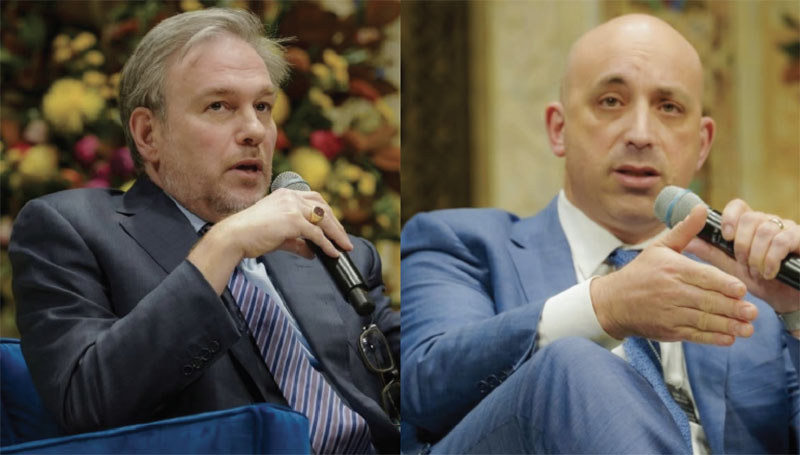
Orthodox, Conservative and Reform rabbis attended a summerbrunch and took away “T’shuvah” greeting cards featuring artwork byRaphael Abecassis. Left to right, Joshua Bittan, Rabbi Zvi Block,Rabbi Haim Louk, Rabbi Alan Freehling, Rabbi Paul Dubin, Rabbi JoelRembaum, Rabbi Marvin Sugarman and Rabbi Yaacov Deyo.
“Jewish tradition teaches that each year during the month of Elul,the last month of the Jewish calendar, we are to make amends,t’shuvah, to all the people we have harmed during the year. This isdone prior to Yom Kippur as a way of cleansing our souls before westart a new year. Not only are we to wish people a good year on RoshHashanah, but we must take the action necessary to make it a goodyear by making amends, doing t’shuvah.”— From Gateways Beit T’Shuvah’s “T’shuvah” card
T’shuvah, which in Hebrew translates as “repentance, return andresponse,” is not only part of the name of Gateways Beit T’Shuvah,the Los Angeles halfway house for recovering Jewish offenders andaddicts. “It’s very much a part of what we do here,” ExecutiveDirector Harriet Rossetto said during a recent interview.
At this time of year, the 25 male residents of Beit T’Shuvah’sramshackle two-story Victorian headquarters near downtown Los Angelesand the 12 women at the nearby sister facility are deeply engaged int’shuvah, as they prepare for the High Holidays.
The month of Elul “is the perfect time for Jews in recovery to doinventory and look at ourselves, where we’ve been, where we’re at andwhere we’re going,” said Mark Borovitz, Beit T’Shuvah’s spiritualleader and outreach and education director, who himself is inrecovery. The process involves internal searching, making amends,prayer, Torah discussions and listening to the blast of the shofarevery morning “to wake up our souls,” he said.
Borovitz, who did two terms in state prison and two in county jailon felony charges, is studying to be a rabbi at the University ofJudaism. But in the eyes of his Beit T’Shuvah “flock,” he alreadyholds the title. This year, for the first time, Borovitz, who ismarried to Rossetto, will lead Rosh Hashanah and Yom Kippur servicesfor residents of the halfway house, their families and friends at asynagogue — Kehillat Ma’arav in Santa Monica.
For several years, “Rebbe” Borovitz’s Friday-night Shabbatservices, which take place in a tent behind the main facility, havedrawn crowds of up to 100 people — they’re mandatory for theresidents, but most come willingly and bring relatives and friends.The feeling was that “we are already a synagogue and that we shouldofficialize that in some way,” Rossetto said.
So the idea of Congregation Beit T’Shuvah was born.
Beit T’Shuvah and its parent, Gateways Hospital and Mental HealthCenter, are looking into acquiring the site of a former convent inLos Angeles, which would allow them to not only double the number ofthose it serves but add a sober-living facility for “graduates” and achapel for the future synagogue. Although the facility hasn’t beensecured, Rossetto believes that “it’s beshert, meant to be.”
The “T’Shuvah” greeting cards are another High Holiday innovation.The brainstorm of Rossetto, the cards feature a reproduction of acolorful serigraph by well-known Israeli artist Raphael Abecassis.The picture on the cards’ front depicts symbols of addiction on onehalf and of redemption through Judaism on the other. On the inside,there is space for people to write of their own personal t’shuvah.
The original concept was to sell the cards as a fund-raiser forBeit T’Shuvah, but an anonymous donor committed $20,000 to print250,000 cards, which were to be given to synagogues and Jewishrecovery groups during the holidays. Orthodox, Conservative andReform rabbis attended a summer brunch and took away cards to handout to their congregants.
“We want to make a contribution toward bringing individuals intocloser connection with Judaism and what it means,” said GatewaysChief Executive Officer Saul Goldfarb. He praised the Beit T’Shuvahprogram as “a form of lifesaving without the high drama of surgery.”
For some residents, such as 35-year-old Jon H., who asked thatonly his last initial be used, that is literally true. A drug addictfor many years, Jon, a charismatic former DJ and auctioneer, grew upin West Los Angeles and celebrated his bar mitzvah at Vista Del Mar,a psychiatric inpatient group home for abused and troubled children.Shuttled between parents as a child and, as an adult, fired andrehired from the same job five times, Jon said that drugs “filled thehole [inside him] like nothing else.” After a relapse, Jonrecommitted himself to Beit T’Shuvah — a common experience amongaddicts. “I got well too quickly,” he said. “I cleaned up on theoutside, but not on the inside.” This time around, Borovitz haswarned him that if he doesn’t get the spiritual side of recovery,”I’m going to die.”
During the period leading into the High Holidays, Borovitzstresses the fourth through ninth steps of the 12-step recoveryprogram — those that deal specifically with taking a moralinventory, sharing it with someone close to you, making a list ofthose we’ve hurt, and making amends.
As part of his spiritual preparation, Jon has been doing a lot ofsoul-searching. “I haven’t gotten that far,” he said. “I’ve done somewriting and praying, some introspection about where I’ve missed themark this year.”
Specifically, he sent t’shuvah cards to those he had hurt — hisparents, an ex-girlfriend, an ex-employer — apologizing for harm hehad done and asking their forgiveness. “It’s a kind of personalhousecleaning,” he said. “I’m trying to get right with my fellows sothat on the High Holidays, I can get right with God.”
For more information on Gateways Beit T’Shuvah or High Holidayservices, call (213) 644-2026.






















 More news and opinions than at a Shabbat dinner, right in your inbox.
More news and opinions than at a Shabbat dinner, right in your inbox.